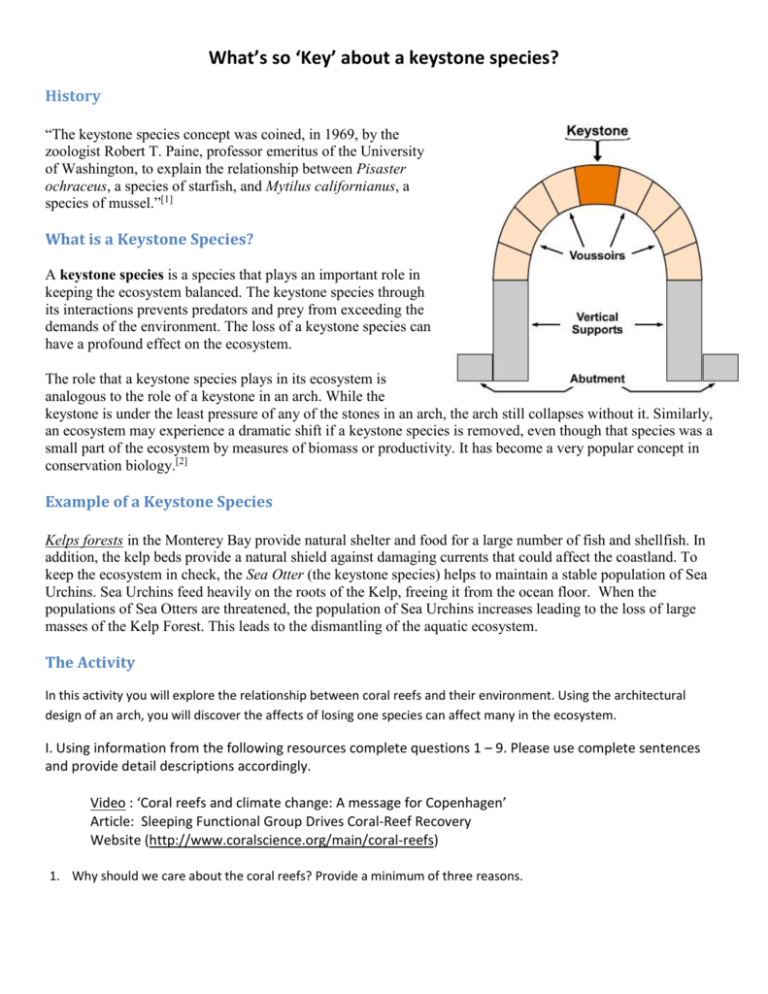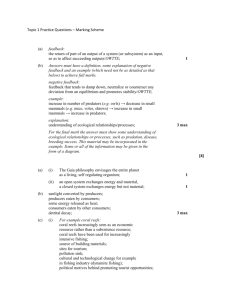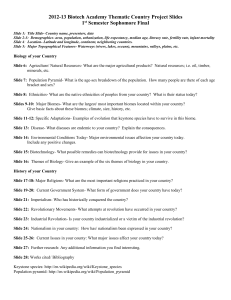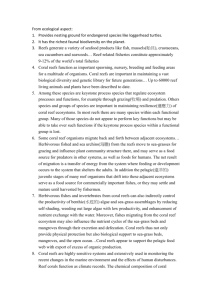Keystone Species Activity
advertisement

What’s so ‘Key’ about a keystone species? History “The keystone species concept was coined, in 1969, by the zoologist Robert T. Paine, professor emeritus of the University of Washington, to explain the relationship between Pisaster ochraceus, a species of starfish, and Mytilus californianus, a species of mussel.”[1] What is a Keystone Species? A keystone species is a species that plays an important role in keeping the ecosystem balanced. The keystone species through its interactions prevents predators and prey from exceeding the demands of the environment. The loss of a keystone species can have a profound effect on the ecosystem. The role that a keystone species plays in its ecosystem is analogous to the role of a keystone in an arch. While the keystone is under the least pressure of any of the stones in an arch, the arch still collapses without it. Similarly, an ecosystem may experience a dramatic shift if a keystone species is removed, even though that species was a small part of the ecosystem by measures of biomass or productivity. It has become a very popular concept in conservation biology.[2] Example of a Keystone Species Kelps forests in the Monterey Bay provide natural shelter and food for a large number of fish and shellfish. In addition, the kelp beds provide a natural shield against damaging currents that could affect the coastland. To keep the ecosystem in check, the Sea Otter (the keystone species) helps to maintain a stable population of Sea Urchins. Sea Urchins feed heavily on the roots of the Kelp, freeing it from the ocean floor. When the populations of Sea Otters are threatened, the population of Sea Urchins increases leading to the loss of large masses of the Kelp Forest. This leads to the dismantling of the aquatic ecosystem. The Activity In this activity you will explore the relationship between coral reefs and their environment. Using the architectural design of an arch, you will discover the affects of losing one species can affect many in the ecosystem. I. Using information from the following resources complete questions 1 – 9. Please use complete sentences and provide detail descriptions accordingly. Video : ‘Coral reefs and climate change: A message for Copenhagen’ Article: Sleeping Functional Group Drives Coral-Reef Recovery Website (http://www.coralscience.org/main/coral-reefs) 1. Why should we care about the coral reefs? Provide a minimum of three reasons. 2. What are some known predators to the coral bed? Provide a minimum of three examples 3. The batfish is considered a keystone species for coral. What is their role in the ecosystem? How does the batfish contribute to the health of the coral beds? . 4. What organisms rely on the coral reefs for survival 5. What areas of the globe are coral reefs found (list 4)? 6. What two important functions do coral reefs provide an ecosystem? 7. What are the downstream effects of destruction to coral reefs? 8. Using the information that you have gathered draw an arch with the batfish as the ‘keystone’. Indicate what would happen to a coral reef if the batfish populations were overfished. 6_______ __ 2_________ 1_____ _____ 7___________ 3_________ 8________ 4_________ 9________ 5________ 9. What can be done to preserve reefs?







